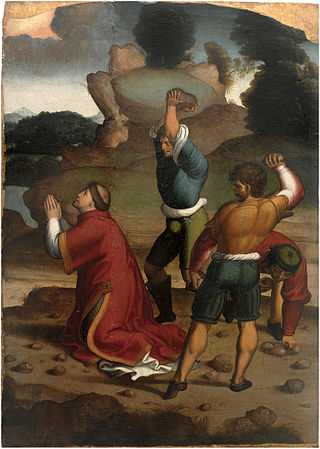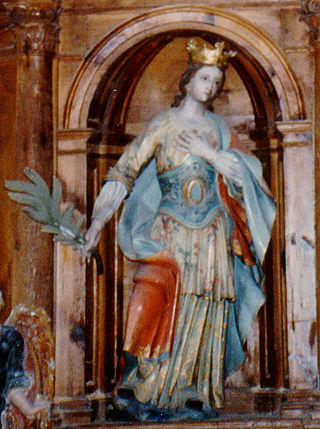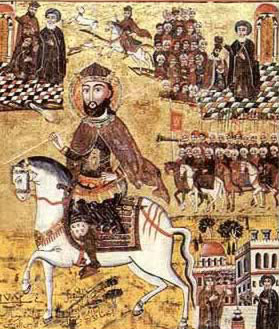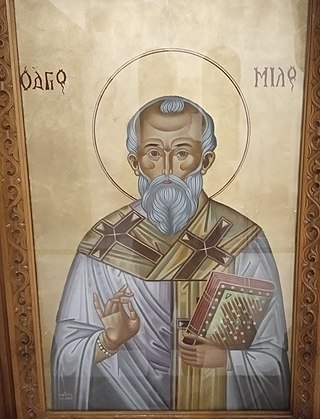
Agnes of Rome is a virgin martyr, venerated as a saint in the Catholic Church, Oriental Orthodox Church and the Eastern Orthodox Church, as well as the Anglican Communion and Lutheran Churches. She is one of several virgin martyrs commemorated by name in the Canon of the Mass, and one of many Christians martyred during the reign of the Roman emperor Diocletian.

Catherine of Alexandria, also spelled Katherine is, according to tradition, a Christian saint and virgin, who was martyred in the early fourth century at the hands of the emperor Maxentius. According to her hagiography, she was both a princess and a noted scholar who became a Christian around the age of 14, converted hundreds of people to Christianity and was martyred around the age of 18. More than 1,100 years after Catherine's martyrdom, Joan of Arc identified her as one of the saints who appeared to and counselled her.

Shapur II, also known as Shapur the Great, was the tenth Sasanian King of Kings (Shahanshah) of Iran. He took the title at birth and held it until his death at age 70, making him the longest-reigning monarch in Iranian history. He was the son of Hormizd II.

Aelia Pulcheria was an Eastern Roman empress who advised her brother emperor Theodosius II during his minority and then became wife to emperor Marcian from November 450 to her death in 453.

In Christianity, a martyr is a person who was killed for their testimony for Jesus or faith in Jesus. In years of the early church, stories depict this often occurring through death by sawing, stoning, crucifixion, burning at the stake, or other forms of torture and capital punishment. The word martyr comes from the Koine word μάρτυς, mártys, which means "witness" or "testimony".

The Martyrs of Córdoba were forty-eight Christian martyrs who were executed under the rule of Muslim administration in Al-Andalus. The hagiographical treatise written by the Iberian Christian and Latinist scholar Eulogius of Córdoba describes in detail the executions of the martyrs for capital violations of Islamic law (sharīʿa), including apostasy and blasphemy. The martyrdoms recorded by Eulogius took place between 850 and 859 AD, which according to the Mālikī judges of al-Andalus broke the treaty signed between Muslims and their Christian subjects.

Columba of Spain was a virgin and nun who was born in Córdoba, Spain, and martyred around 853 by the Muslim rulers in Spain, during a persecution of Christians. She is a part of the Martyrs of Córdoba and venerated as a saint in the Catholic Church. Her feast day is September 17. Her cult was probably a combination of two virgin martyrs, Colomba of Spain and Columba of Sens, a third century French martyr.

Crispina was a virgin martyr of Africa who suffered during the Diocletian persecution. She was born at Thagora, a town in the Roman province of Numidia, located in Taoura, Algeria. in North Africa.) She died by beheading at Theveste, in Numidia.
Abdisho and Abda were two successive bishops of Kashkar who were martyred along with 38 companions in 376 during the Forty-Year Persecution in the Sasanian Empire.

Mar Shimun Bar Sabbae was the Assyrian Bishop of Seleucia-Ctesiphon, from Persia, the de facto head of the Church of the East, until his death. He was bishop during the persecutions of King Shapur II of the Sasanian Empire of Iran, and was executed along with many of his followers. He is revered as a saint in various Christian communions.

Dorothea of Caesarea is a 4th-century virgin martyr who was executed at Caesarea Mazaca. Evidence for her actual historical existence or acta is very sparse. She is called a martyr of the late Diocletianic Persecution, although her death occurred after the resignation of Diocletian himself.
Flora and María were the first two of nine female Christian Martyrs of Córdoba. After denouncing Islam before an Islamic judge, they were imprisoned. Though threatened "with being thrown upon the streets as prostitutes", they were eventually beheaded. They are commemorated on 24 November.

Saints Behnam, Sarah, and the Forty Martyrs were 4th-century Assyrian Christians who suffered martyrdom during the reign of Shapur II. They are venerated as saints in the Assyrian Church of the East and Oriental Orthodox Churches.

The Guernsey Martyrs were three women who were burned at the stake for their Protestant beliefs, in Guernsey, Channel Islands, in 1556 during the Marian persecutions.

Crispus, Crispinianus and Benedicta were Roman Christian martyrs, venerated after their death as saints. According to hagiographical accounts, their death followed as a result of the martyrdom of Saints John and Paul. According to the Acta Sanctorum, they were killed during the reign of Julian. This would place their deaths during the years 361 to 363 AD. The traditional date of their martyrdom is 27 June 362.
The Acts of Pusai or Martyrdom of Pusai is a Syriac narrative about the martyrdom of a Christian saint named Pusai. English-speaking literature refers to this work by a variety of names, including the Martyrdom of Pusai-Qarugbed, on account of Pusai's title Qarugbed, "Head of the Craftsmen", and as the "Martyrdom of Pusay. Other variants include Acts of Mar Pusai and the Passions of Pusay.

Miles, sometimes Mar Miles, was the bishop of Susa in Sasanian Persia from before 315 until his martyrdom in 340 or 341. He engaged in efforts to evangelize Susa, traveled widely in the Eastern Roman Empire and led the opposition to Papa bar ʿAggai and the supremacy of the bishops of Seleucia-Ctesiphon in the Persian church. He was executed by the Sasanian authorities at the start of the Forty-Year Persecution.

The Martyrs of Persia under Shapur II were Assyrian Christian martyrs who were put to death by Shapur II of Persia for failing to renounce their faith. There may have been several thousand in total. They are remembered as a group in the Roman and Orthodox calendars. The Roman Martyrology gives feast days of 6 April, 22 April and 9 May for different groups.
Saint Lewina was a British virgin and martyr who was put to death by Saxon invaders. Her feast day is 24 July.













